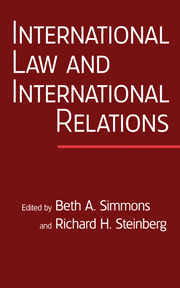Book contents
- Frontmatter
- Contents
- Contributors
- Abstracts
- Preface
- Editors' Note
- PART I INTERNATIONAL REGIMES THEORY: DOES LAW MATTER?
- PART II COMMITMENT AND COMPLIANCE
- PART III LEGALIZATION AND ITS LIMITS
- PART IV INTERNATIONAL LAW AND INTERNATIONAL NORMS
- PART V TREATY DESIGN AND DYNAMICS
- PART VI LAW AND LEGAL INSTITUTIONS
- 18 Europe Before the Court: A Political Theory of Legal Integration (1993)
- 19 The European Court of Justice, National Governments, and Legal Integration in the European Union (1998)
- PART VII OTHER SUBSTANTIVE AREAS OF INTERNATIONAL LAW
- References
- Index
19 - The European Court of Justice, National Governments, and Legal Integration in the European Union (1998)
Published online by Cambridge University Press: 05 June 2012
- Frontmatter
- Contents
- Contributors
- Abstracts
- Preface
- Editors' Note
- PART I INTERNATIONAL REGIMES THEORY: DOES LAW MATTER?
- PART II COMMITMENT AND COMPLIANCE
- PART III LEGALIZATION AND ITS LIMITS
- PART IV INTERNATIONAL LAW AND INTERNATIONAL NORMS
- PART V TREATY DESIGN AND DYNAMICS
- PART VI LAW AND LEGAL INSTITUTIONS
- 18 Europe Before the Court: A Political Theory of Legal Integration (1993)
- 19 The European Court of Justice, National Governments, and Legal Integration in the European Union (1998)
- PART VII OTHER SUBSTANTIVE AREAS OF INTERNATIONAL LAW
- References
- Index
Summary
The growth of European law has been central to the broader process of European integration. The accretion of power by the European Court of Justice (ECJ) is arguably the clearest manifestation of the transfer of sovereignty from nation-states to a supranational institution in modern international politics. The ECJ is more similar to the U.S. Supreme Court than to the International Court of Justice or the dispute panels of the North American Free Trade Agreement (NAFTA) and the World Trade Organization (WTO). The Court interprets European Union (EU) treaties as if they represent a de facto constitution for Europe and exercises judicial review over laws and practices within member states. The ECJ is thus in the business of declaring extant national laws and the behavior of national governments “EU-unconstitutional.” Even more significantly from the standpoint of conventional international relations, member governments often abide by such decisions.
There are two perspectives on the evolution and operation of Europe's remarkable legal system. The legal autonomy approach argues that the ECJ has been able to push forward its European integration agenda against the interests of some member states. According to this view, national governments paid insufficient attention to the Court's behavior during the 1960s and 1970s when the Court developed a powerful set of legal doctrines and co-opted the support of domestic courts for them.
- Type
- Chapter
- Information
- International Law and International RelationsAn International Organization Reader, pp. 486 - 512Publisher: Cambridge University PressPrint publication year: 2007



